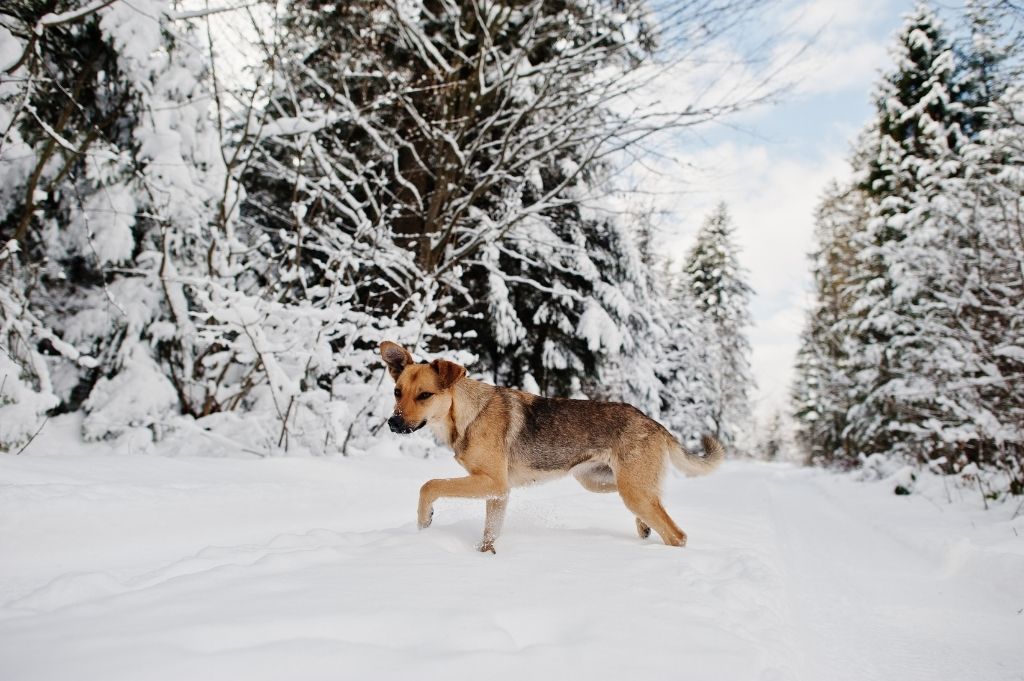The cold winter months can present an increase in dog knee injuries in northern climates with slippery icy conditions. Whether your dog has recovered from dog knee surgery or if you are looking to prevent a tear in your dog’s ACL, then there are a few things to consider during the iciest times of year.
Winter lameness in dogs is a serious phenomenon and contributes significantly to re-injury of already torn CCLs and can cause new knee injuries for dogs. Often dogs, when off leash will wander into terrain that their owners are not walking on. If there is ice under the snow, a slip, turn, or pivot can cause re-injury or a first time injury to the cruciate ligament in dogs.
This does not mean that every dog needs to winter in warmer climates; however, it does mean that owners can take a few extra precautions during the coldest months of the year to keep their dog’s knees healthy!
Where Is Your Dog Walking: Be Aware Of The Terrain Where Your Dog Is Playing
If you live in a colder climate then you know that under a foot or two of snow there can often be a layer of ice. If you take your dog to a dog park during the winter, be cognizant that just because the area where you may be standing has been salted does not mean that your dog will not wander out to slippery and icy locations.
A wrong pivot on the hind legs while on ice can lead to that disastrous ‘popping’ sound of a torn CCL, and leave your dog limping in pain. Of course, it is important to keep a regular exercise routine up during the cold winter months, but be aware of the surface that your dog is playing on, especially off leash. Dog’s do not have the ability to grip the ground while on ice the same way they would on dirt, or asphalt.
It is best to avoid walking your dog across a frozen lake, not only to protect them from slipping and sliding and causing harm to their knee joint. Dogs tend to wander off to areas that may present thinner ice.
As an owner do your best to keep your dog walking on surfaces that will allow them to grip the ground during the cold winter months. This will help avoid a re-injury or a fresh injury to the hind knees.
Have Your Dog Wear A Knee Brace If Surgery Has Already Occurred
If you have chosen knee surgery for your dog, then be aware of the risk that the winter months present for re-injury to your dog’s knee. Be sure that if you are taking your dog for a walk or to the dog park, that they wear their dog knee brace, particularly when conditions are icy.
Icy conditions are hard to navigate safely for dogs who have previously injured their hind knee. This is because unusual motions to self correct, pivot, or slide are prevalent. Many more dog knee injuries happen during the coldest months of the year because of this.
If your dog has already undergone knee surgery you will want to secure their dog knee brace snugly around the knee that has been operated on to help prevent re-injury,
Keep Your Dog’s Muscles and Joints Warm During The Cold Winter Months
Just like humans, dogs’ muscles should be warmed up before engaging in rigorous exercise. This can be tricky to do with a dog, as many of them bound out of the house on a cold winter morning excited to play in the snow.
Consider suiting your dog up with a warm thermal jacket or vest. This will keep their muscles warm and help prevent ligament tears. If the core temperature of your dog is regulated through clothing this can also help prevent winter knee injuries for your dog.
Dog Owners Should Be Extra Cautious When Walking Their Dog’s During The Cold Winter Months: To Keep You Both Safe
As important as your dog’s health is during the winter months, it is also necessary for the owner to stay safe. If you are walking your dog on a leash and they have a tendency to tug and pull, you may want to consider wearing shoes with cleats to prevent slipping.
If you are managing to keep your dog’s knees safe during the winter months, then you will also want to keep your knees safe too! Dress appropriately, and take additional precautions during the cold months of the year while walking your dog.
Knowing that dog knee injuries increase in more northern climates will help you, the owner, to keep your dog’s knees safe and injury free even in icy conditions!
Sources Cited:
- https://ivcjournal.com/winter-lameness/
- https://www.whole-dog-journal.com/health/canine-knee-injury-brace-yourself/
- https://badgervet.com/walking-your-dog-in-winter/

